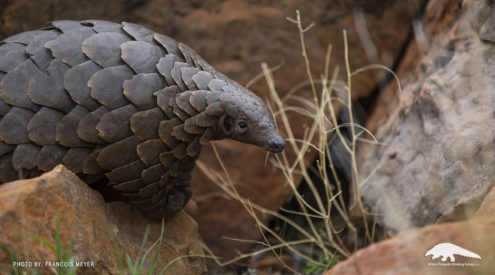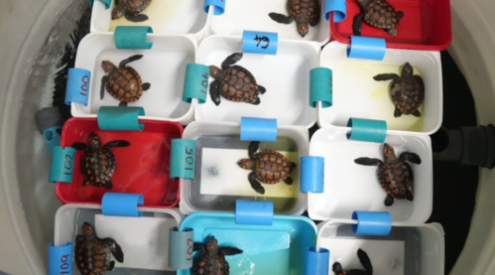Photo by Yolandi Grobler
In his book, Great Tuskers of Africa, impassioned author and photographer, Dr Johan Marais describes the ‘animal of our kings’, ‘lord of the trees,’ and ‘master of the valleys’ as references to the African elephant in traditional folklore. Incredibly descriptive of the sweeping grace of these venerated creatures, some of whom possess ivory in excess of 45 kg, awarding them the title of Great Tusker. Bulls’ tusks grow throughout their long lives, some carrying bigger tusks than others, a gene that is sought after by females and revered in battle.
Johan emphasised the danger Africa’s elephants are facing and just how rare these great tuskers are:
“There are currently less than 50 of these bulls in Africa, out of an estimated population of 450 000 elephants. Poaching is at its height since the 1980s in Central and East Africa, with about 40 000 ellies that were killed last year for their ivory. So these big tuskers are under severe pressure and soon this ivory war WILL spread south towards us.”
You may know about the Magnificent Seven, Kruger’s most impressive tuskers (all of whom died during the 80s.) Here are 6 other remarkable bulls from the past who should be recognised as some of Kruger’s greatest tuskers. “Mandleve, Phelwane and Duke must have been the three biggest tuskers in KNP so far,” explained Johan. The remaining three? Well, they just fall subject to his personal favouritism. Although these tuskers have passed into the realm of history, you can keep a look out for the two up-and-coming greats on your next trip to the Kruger National Park.
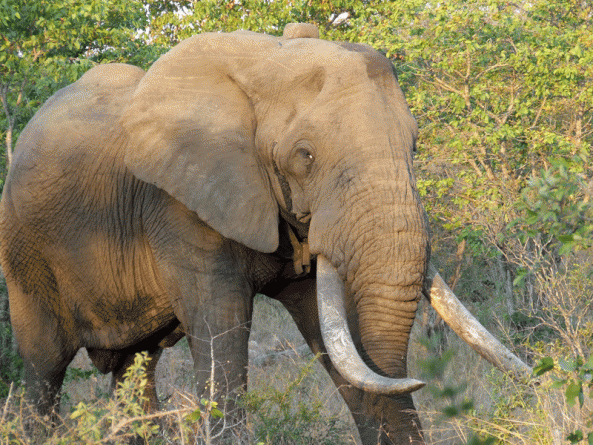
Mac is currently roaming enormous circuits of approximately 7000 sq. km between the Kruger and the Timbavati Private Reserve every year. An astounding great tusker whose progress is followed by many using his satellite collar. Image taken by Dr Michelle Henley in the Timbavati Reserve.
Photo by Dr Michelle Henley
Mandleve (died 1992)
This elephant truly was a great tusker; in fact, his tusks were the greatest of them all. Mandleve, a Tsonga word meaning ‘ear’, spent his life roaming amongst the thorny thickets of the south-western Kruger Park and also in the Sabi Sabi, offering guests at Sabi Sabi Lodge some of the most memorable safari sightings of their lives. To approach an elephant commanding the pointed ivory weighing the equivalent of 2 average sized people sends perspective rushing to the forefront of the brain. Mandleve’s more-or-less evenly long tusks boasted 69kg and 73.5kg apiece, taking the record for Kruger’s heaviest ivory. He was a mentor to, once, 12 askaris at one time; recognisable not only by his colossal tusks, but his uniquely carved left ear. In late 1993, Mandleve’s skeleton was discovered, equipped with his enormous tusks, which were removed and are now displayed at Letaba Elephant Hall as SANPark’s collection’s heaviest.
Phelwana (died 1988)
An elephant’s desire for citrus fruit is fairly significant and I’ve often heard words of advice about keeping oranges on safari! Phelwana made a name for himself with a local farmer whose naartjie trees were often picked upon by this enormous tusker, creating a comedic (for the reader) love-hate relationship between the two. Phelwana’s massive ivory weighed in at a combined 135.5kg, topped only by Mandleve. He regularly overrode western boundary fences near the Orpen Gate, granting himself access to the neighbouring Manyeleti and Timbavati Reserves. This giant did not see a peaceful end waiting for his final set of molars to wear thin; Phelwana had to be put down after he was discovered in an emaciated condition, suffering from a septic bullet wound in his lower jaw. He is remembered as a gentle giant.
Duke (died 2011)
Duke is the tusker most recently lighting up the Kruger’s hall of fame for his monstrous tusks that, should they have remained intact at a combined 134.15kg, could vie for the title of latest, greatest tusker. Duke was an elephant bull who seemed to have played too roughly with his magnificent ivory, breaking first his left and then his right. Luckily, the broken tusk Duke left behind at the stump of the leadwood tree he was trying to uproot was traced and recovered by rangers, as was the 32kg section of ivory he broke off on a second occasion. Often approachable to humans, Duke was a photographic dream, sticking to popular tourist routes in the Park, openly sharing his renowned presence with adoring fans. Sadly, the very year following his collaring, Duke was discovered dead alongside the Makambeni Stream; no signs of a fight led experts to believe it was likely a natural death at around 55 years old.
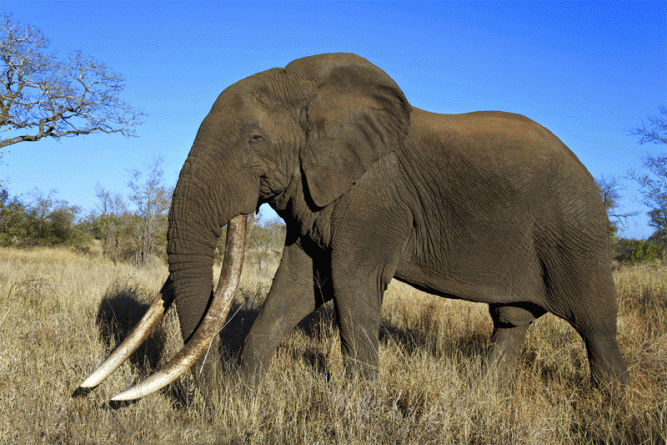
An image of Duke and his incredible tusks before they were broken off. Luckily the massive pieces of ivory were recovered and are preserved in the ivory stores at Skukuza.
Photo by Johan Marais
Mabarule (died 2004)
Earlier on in Mabarule’s life, he was misidentified as a fellow tusker in the area, Hatlani. After Hatlani’s saddening death from a suspected heart attack, Mabarule was rightly recognised as the gloriously tusked bull in northern Kruger’s Mooiplaas area. This elephant was described as one of the most docile ever to have been photographed by Johan, and his life in his home range brought him into contact with many adulating fans. His left tusk swooped right down, almost sweeping the ground, while his right one curved up, giving this bull an ironically unmistakable look. When Mabarule’s carcass was found, tragic facts were revealed about the state of his health. Arthritis calcification in his vertebrae showed that he was undoubtedly in terrible pain towards the end of his life; however, his gentle, unruffled nature shone through until the end.
Hlanganini (died 2009)
One of Kruger’s most recently deceased great tuskers, Hlanganini, owned some of the most symmetrical tusks of the ivory carriers in the area. Hlanganini was a perfect example of why we need to allow these impressively tusked bulls to age; Johan witnessed this legendary elephant’s tusks transform into something exceptional in only a matter of years. In August of 2009 when Hlanganini’s largely decomposed carcass was discovered, it was with sorrow that rangers realised this old bull had not gone peacefully, but in a brutal battle for dominance. Puncture wounds were found to have cracked his skull and the positioning of his body showed how this great tusker had fallen to his knees and died, defeated.
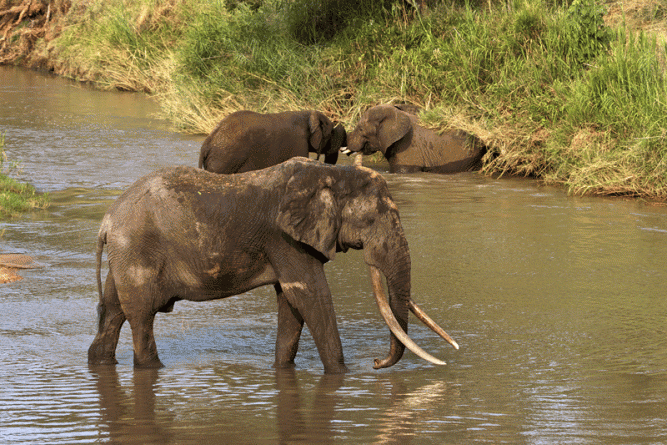
Hlanganini was one of Kruger's greatest losses as one of the latest generation's largets ivory carriers. His carcass was only discovered 2 months after his death and upon inspection it is assumed that he died in a fatal bull fight. Image taken by Johan Marais.
Photo by Johan Marais
Tshokwane (died 1998)
Tshokwane is remembered well for both his distinguished tusks and his fiery response to too-close human contact. This magnificent animal was almost tracked down and shot by rangers after he almost killed renowned photographer, Daryl Balfour, in a charge. Tshokwane’s life was saved when it was determined that his charge was in response to human interference and not out of a malicious nature. A distinctive notch in his right ear and an extraordinary right master tusk singled this great bull out from the rest, until he was spotted sporting the shortened remains of broken tusks, which had been fragmented on different occasions. In 1998, Tshokwane came off second best in a pitiless bull fight that fatally wounded his body, causing a sad and painful end to the life of this great Kruger tusker.
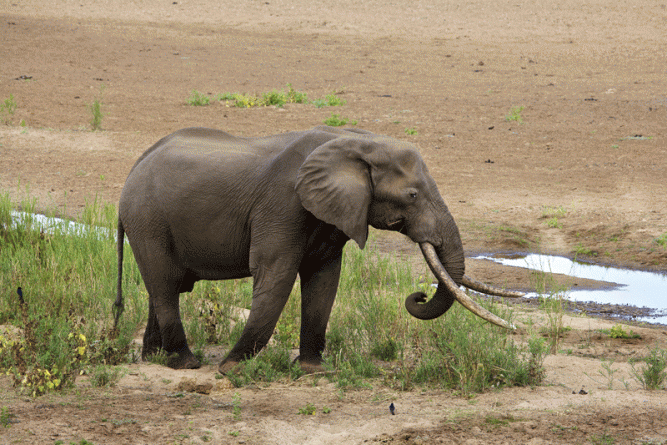
Masthulele is currently one of Kruger's emerging great tuskers. His name, meaning 'the quiet one' aptly describes his elusive presence, but he has been nominated as one of Kruger's top 10 and is being monitored closely. Image taken by Johan Marias.
Photo by Johan Marais
This post is brought to you by Sun Safaris, organisers of Southern and East African safaris, holidays and nominees in the category of ‘Africa’s Leading Safari Company’ for the World Travel Awards 2013. Check out Sun Safaris on Facebook, Twitter and Pinterest and vote for them below.











